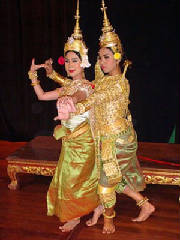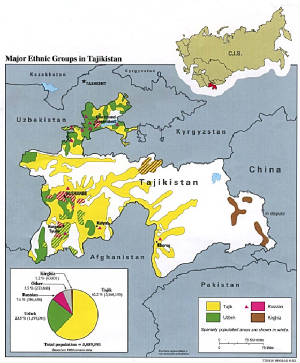|
Cambodian classical dance drama revival.

These photos were taken after the classical dance performance of Vong Sovann Chann Savat
had ended to loud applause at the Chaktomuk Theatre on Saturday evening. UNESCO, who proclaimed the Royal Ballet of
Cambodia as a masterpiece of oral and intangible heritage of humanity in 2003, were instrumental in reviving this classical
dance drama. My photos don't do the work or the performers justice as I've come to realize that my Sony cyber-shot digital
camera simply isn't good enough for theatre pictures indoors, so apologies for the quality. Nevertheless, it was great to
see my friend Sam Savin performing the lead role of princess Tep Sokun - she's been
dancing since she was twelve, she's now 29 and has performed abroad many times in major performances and tours such as Dance:
The Spirit of Cambodia, Seasons of Migration, she starred as Pamina Devi in the dance of the same name and countless other
productions. When she's not dancing, which is rare, she teaches dance at the Royal University of Fine Arts. Chaktomuk was
full to bursting for the performance with invited guests and just a handful of barangs on view - I had intended to gripe here
about the lack of publicity for the event but if its a full-house then their view is that PR isn't necessary. However, one-off
performances like this don't allow a wider audience to view this important artistic display of Cambodia's culture and whilst
I'm not advocating a run of shows such as Where Elephants Weep enjoyed, at least two or three performances would give others
a chance to experience the grace and beauty of the show. A bonus point was the colour programme, which gave an easy-to-follow
summary of the drama, which enhanced my understanding and enjoyment of the work, and other details in both English and Khmer.
First of its kind Youth Assembly to be held at Hyderabad

Youth Assembly with an aim to sensitize youth towards community service and social entrepreneurship to be
held at Hyderabad. About 1500 youth from various colleges and universities across India are expected to participate. Several
youth and achievers such as Mr. Rajdeep Sardesai, Chairman, CNN-IBN; Mrs. Amala Akkineni, Founder Secretary, Blue Cross Society
of Hyderabad; Filmstar Nagarjuna; Mrs. Soumya Mishra, DIG, AP Special Police; Dr. Jaya Prakash Narayan, Founder - Lok Satta;
Ms. Karuna Gopal, President - Foundation for Futuristic Cities; Mrs. Farida, Directory - World Wildlife Fund, A.P. Region;
Mr. Karunya & Ms. Bhargavi Pillai, playback singers and many others will share their success stories and inspire the participants.
The first of its kind Youth Assembly will be held in Hyderabad with an aim to sensitize youth towards community service
and social entrepreneurship. About 1500 youth from various colleges and universities across India are expected to participate.
Several youth and achievers such as Mr. Rajdeep Sardesai, Chairman, CNN-IBN; Mrs. Amala Akkineni, Founder Secretary, Blue
Cross Society of Hyderabad; Filmstar Nagarjuna; Mrs. Soumya Mishra, DIG, AP Special Police; Dr. Jaya Prakash Narayan, Founder
- Lok Satta; Ms. Karuna Gopal, President - Foundation for Futuristic Cities; Mrs. Farida, Directory - World Wildlife Fund,
A.P. Region; Mr. Karunya & Ms. Bhargavi Pillai, playback singers and many others will share their success stories and
inspire the participants. The two-day youth assembly is a conglomeration of youngsters who wish to make a difference to their
world, informs Mr. Vinayak Kalletla, Founder Principal - Abhyasa Residential Public School, the organisers. The entry to the
Assembly is free.
To be held in Sri Satya Sai Nigamagamam in Hyderabad on 12th and 13th September for two days, this is the maiden annual
gathering of hundreds of young people who seek practical ways to contribute to the achievement of millennium development goals
of United Nations. The assembly is being organised by Abhyasa Residential Public School along with Passionate, a NGO.
Youth is the hope of the nation, we are more concerned about their future. But, what about their ‘today’. Almost
all of us think of their future. Nobody is worried about their ‘present’. They are the mighty force. Let us make
use of their ‘today’ to make their tomorrow more better for them and us. Half of the population is youth. They
are hard working and good looking. They have smartness and brains. They are very good at community service. The fact that
sixty per cent of blood donors in this country comprise of youth has proved that they are socially concerned, says Mr. Vinayak.
Mr. R. Prabhakar Rao, I.P.S. (Retd. DGP of A.P.) and Chairperson of Abhyasa School informs that the Youth Assembly is the
platform which enables each participants to explore possibilities to make a difference to the world by being an aware and
active citizen and confronting the challenges of the present.
Master Chaitanya, Founder Secretary, Passionate informed that the highlight of the meet is the participation of several
youth achievers from the field of administration, sports, media, entertainment, social activities and social entrepreneurs.
They will be sharing their success stories and initiating panel discussion to inspire the participants.
Community service and social entrepreneurship must be inculcated among generation next. They are not less than any best
of the best social workers in the country. Youth and community service, none can beat them. They have the power and zeal.
They too have responsibility towards their society, social fabric. Let us not undermine their social awareness and concerns.
They know about it. But, what lacks is the proper avenues and initiatives. This is one such an event which draws youth attention
into community service, says Mr. Vinayak.
For more information on Youth Assembly of Hyderabad, Mr. Vinayak Kalletla, Founder Principal - Abhyasa School can be reached
on Tel: 98480-53745
China plans to increase the quota for government sponsored overseas students, an official with the China Scholarship Council
(CSC) said Monday.
The country will offer 20,000 overseas students scholarships in 2010, doubling that of 2007, Liu Jinghui, CSC secretary-general,
said at the China-ASEAN education exchange week in Guiyang, Guizhou province. Overseas students who are awarded scholarships
will be given subsidies covering living and tuition expenses, Liu said. "China has paid great attention to education, and
overseas students are also very important," Liu said.
He said these students will help Chinese universities become more international. The country is expected to welcome
500,000 overseas students by 2020, including self-sponsored ones, Liu said. China increased the living subsidy for overseas
students by almost 50 percent this year from that of last year.
It is now 1,400 yuan ($200) per month for an undergraduate student. The monthly subsidy for overseas graduates and PhD
candidates was also increased to 1,700 yuan and 2,000 yuan respectively this year. Among all subjects offered to international
students, Chinese language, medicine and management are the most popular.
China's environment for international students has become more friendly with better management, living, schooling and medical
insurance, Cao Guoxing, director of the international cooperation and exchange department of the Ministry of Education, said
earlier.
The ministry adopted a number of measures last year to enhance the development of studying in China including the use of
English as a medium of instruction. Diplomas awarded to foreign students meet the highest standards.
China received more than 190,000 overseas students last year, almost five times that of 1997. They came from 188
countries and regions, and 5.2 percent of them were offered Chinese government scholarships.
South Korea, Japan, the United States, Vietnam and Thailand were the top five countries that had the largest number of
international students in China last year. Xinhua contributed to the story
Japan Announces Plan to Enroll More Foreign Students
Tokyo — Japanese government officials announced today some details of an ambitious plan to nearly triple the
country’s enrollment of foreign students, to 300,000 in 12 years, the Asahi Shimbun newspaper reported.
The plan, disclosed amid a looming enrollment crisis at Japanese universities, will ease visa restrictions, improve accommodations, increase Japanese-language teaching, and help
foreign students find work in the country after graduation.
About 30 of Japan’s top universities will be designated as key centers for the “opening up of higher education
to foreign students,” according to a joint announcement by the ministries of education, justice, and foreign affairs,
and other bureaucracies. Specific details on each measure were not provided.
About 119,000 foreign students are now at Japanese universities, down from a peak of 122,000 in 2005. Prime Minister Yasuo
Fukuda pledged to raise the figure to 300,000 by 2020 in a January policy speech. But today’s statement, which includes
proposals to seek funds in next year’s federal budget, is the first concrete sign that Japan’s slow-moving bureaucracy
is gearing up to bring the plan to fruition. —David McNeill Posted on Tuesday July 29, 2008 | Permalink |

The Center for Asia-Pacific Women in Politics (CAPWIP) and the United Nations International Strategy for Disaster Risk
Reduction (UN/ISDR) are pleased to invite you to the Third Global Congress of Women in Politics and Governance which will
be held on October 19-22, 2008 at the Dusit Thani Hotel, Makati City, Metro Manila, Philippines. The theme of the congress
is �Gender in Climate Change and Disaster Risk Reduction.� Gender experts have raised concern over the
absence of women in the discourse/debate on climate change and disaster risk reduction, both of which are global mainstream
issues that are currently impacting the entire world. The involvement of women in areas of environmental management and governance
should not be perceived as an afterthought. Women's roles are of considerable importance in the promotion of environmental
ethics. The current imperative is for women to understand the phenomenon of climate change and disaster risk reduction
and their impacts and implications at the individual, household, community and national levels. Studies show that women have
a definite information deficit on climate politics, climate protection, and preparedness through disaster risk reduction.
Only with this information can women take their proper, significant and strategic role in the issues of climate change and
disaster risk reduction. Invited to this congress are female and male participants from: National & Local Parliaments/Legislative
Bodies; National & Local Governments; Environment Organizations; National & Local Disaster Bodies & Agencies;
Policy Advocacy Groups on Gender, Environment and Preparedness and Disaster Risk Reduction; Disaster Aid/Relief Organizations/Bodies;
Gender Organizations; National Committees on Women; National and Local Environment Ministries; Youth Leaders & Media Practitioners;
Funding/donor agencies/organizations. The Congress has the following objectives: Overall Purpose: To provide
a forum for policy advocates, legislators and decision-makers in national and local governments and leaders at all levels
in formulating gender-responsive legislation and programs related to climate change and disaster risk reduction. Specific
Objectives: a) to understand the phenomenon of climate change, its impacts, and its implications and study the appropriate
risk reduction strategies; b) to review and examine the gender aspects in climate change and disaster risk reduction
and formulate appropriate actions to address these; c) to define the roles women can play in addressing the impacts
of climate change and disaster risk reduction programs and policies at the global, national and sub-national levels; and d)
to identify and define the action agenda for national and local legislators/parliamentarians, policy advocates, and leaders
to support global and national actions to adapt gender responsive legislation and programs related to climate change and disaster
risk reduction. Congress Proceedings: The discussion on gender in climate and disaster risk reduction change
will be organized around identifying the challenges to action as well as defining the appropriate responses to effectively
address the impacts of climate change and disaster risk reduction. Inputs to the discussion will be collected and organized
around: 1) geographic location and 2) types of actions: i.e. preparedness, risk reduction: building community resilience;
adaptation; and mitigation. Cross cutting these discussions will be the identification of technologies in aid of responding
to climate change and preparedness thru disaster risk reduction. The focus of the discussions will revolve around
defining and elaborating actions (i.e. preparedness, disaster risk reduction, adaptation, and mitigation) to cope with climate
change and its impacts and preparedness and disaster risk reduction. Preparedness and disaster risk reduction is about
building individual and community capacities to position themselves and their communities so that the likelihood of climate
change-induced disasters is reduced; the intensity or adverse impacts of disasters are cushioned and that inhabitants are
able to respond promptly, expeditiously and effectively. Adaptation entails actions that moderate harm, or exploit benefits,
of climate change. Mitigation entails actions that minimizes or cushions the adverse impacts of climate change. In
all of these actions, special attention will be given to defining how women and gender could be mainstreamed. In other words,
the Congress should define how women can be given the social space to participate, influence, and benefit from global and
local responses to climate change and preparedness through disaster risk reduction policies, programs and strategies. The
registration fee for the four day congress is One thousand five hundred fifty US Dollars (US$ 1,550.) per person for twin
room sharing accommodations (two persons in one room) and one thousand nine hundred fifty US Dollars (US$ 1,950.) per person
for single room accommodations (one person in one room). The Global Congress will be held on Oct 19-22, 2008. However,
the participants will be requested to be in Manila the day before, October 18, 2008 and leave Manila only on October 23, 2008.
The overnight hotel accommodation on October 18, 2008 is already included in the fee. Participants will be billeted in the
Dusit Thani Hotel, the venue of the congress, and hotels near the Dusit Thani Hotel, accessible within walking distance. Room
accommodations in the Dusit Thani Hotel will be on a first come - first served basis. Importance of the Congress Today,
on the average, one person out of nineteen in a developing country will be hit by a climate disaster, compared to 1 out of
1,500 in an OECD country. Climate change creates life time traps: in Niger, a child born during a drought is 72 percent more
likely to be stunted than a child born during a normal season. We hope that your organization can send participants
to the Third Global Congress of Women in Politics and Governance. The Theme is �Gender in Climate Change and Disaster
Risk Reduction�. This is the first time this will be discussed in a forum whose objective is to formulate gender responsive
legislation, policies, programs and strategies on gender in climate change and disaster risk reduction which we hope will
help legislators and decision makers at all levels in including women in the mechanisms, institutions and processes involving
climate change and risk reduction policies and programs. The Center for Asia Pacific Women in Politics finds it an
honor to have as its partner in convening this congress the United Nations International Strategy for Disaster Risk Reduction
(UN/ISDR). The commitment of the UN/ISDR in including the gender perspective in all its programs on preparedness through disaster
risk reduction is much appreciated and should serve as a model for all. We truly hope that your organization will
find this forum a good opportunity to advocate gender in climate change and disaster risk policies, programs and strategies.
Let us join hands in promoting gender responsive governance through transformative leadership and citizenship. We are looking
forward to your participation. Please download the full information sheet and registration form for this Third Global
Congress of Women in Politics and Governance from our website, http://www.capwip.org/3rdglobalcongress.htm
The Asian Pacific Americans
OCA is a national organization dedicated to advancing the social, political, and economic
well-being of Asian Pacific Americans in the United States. To fulfill its mission, OCA has established
the following goals:
- to advocate for social justice, equal opportunity and fair treatment;
- to promote civic participation, education, and leadership;
- to advance coalitions and community building; and
- to foster cultural heritage.
Founded in 1973 as the Organization of Chinese Americans, OCA aims to embrace the hopes and aspirations
of nearly 13 million Asian Pacific Americans in the United States.
OCA is engaged in organizing its over 80 chapters and affiliates across the nation to develop both leadership
and community involvement. OCA chapters and our organizational and college affiliates are establishing strong local programs
in all parts of the country.
OCA's base in Washington, D.C. gives the national office an effective vantage point for monitoring legislation and policy
issues affecting Asian Pacific Americans. In addition, OCA is able to build national support and to work in coalition with
other national groups around issues affecting Asian Pacific Americans.
OCA takes no collective position on the politics of any foreign country, but instead focuses on the welfare and civil rights
of Asian Pacific Americans in the United States.

Asian Pacific Americans
Issues they stand up for:OCA DISAPPOINTED WITH NEGATIVE IMAGERY IN SUPER BOWL ADS

WASHINGTON DC—OCA, a
national organization with over 80 chapters and affiliates across the country dedicated to ensuring social justice for Asian
Pacific Americans, spoke out today against the frequency of ethnic stereotypes featured in advertising during this
year’s Super Bowl broadcast.
“We were disappointed that some advertising
during last weekend’s broadcast of the Super Bowl, a quintessential celebration of American sports, did not celebrate
American diversity but instead exploited our differences for a cheap laugh,” said Ginny Gong, OCA
National President, “We call on companies to exercise sensitivity and stop the use of such stereotypes in future
advertising.”
Among the objectionable commercials were ads featuring
pandas with stereotypical Asian accents and a character named Ramesh who spoke with a stereotypical Indian accent and had
eight children, and a commercial featuring a cast of immigrants “learning” how to talk to American women.
This year’s Super Bowl was the most watched
sports event and the second-most watched TV program in US history, with an estimated 100 million viewers on Sunday night.
“Those ads incorporating stereotypes of Asians Pacific Americans, and other minority and immigrant groups are all the
more damaging because of the huge audience watching the game,” said Michael Lin, OCA Executive
Director, “We hope that in the future, companies will consider the potential negative effects of their advertising.”
Founded in 1973 as the Organization of Chinese Americans,
OCA is a national organization dedicated to the social, political, and economic well-being of Asian Pacific Americans in the
United States.
Application
Potential facilitators should have work experience in one or more of the following areas:
- Works or has worked in student affairs in a collegiate settings for APIA students or worked directly with APIA students
on their leadership development,
- Teaches or has taught Asian American studies courses AND worked with students directly,
- Currently or has developed and facilitated interactive workshops, trainings and conferences for APIAs
- Possesses an understanding and has demonstrated experience in the areas of social justice, activism, and organizing for
APIAs.
 Facilitator Application Facilitator Application
Applications to be a facilitator for the 2008-2009 are due August 31, 2008.
Save the Tiger: India's Symbol of
Wilderness, Disappearing

To go to India in search of tigers sounds like a Kipling-inspired childhood fantasy. But the fantasy is turning into
a nightmare. A country where tiger is the spirit of Indian jungle, the symbol of Indian wilderness is disappearing slowly
and steadily. Wildlife experts have long pointed out the miserably declining numbers of tigers in India, the situation
has been looming for a long time, and recently when the official figures were released by Government's National Tiger Conservation
Authority it was the final nail on the coffin. Only 1411 tigers remain in India, its shocking if you
see that a century ago there were 40,000 tigers and there has been a decline of 60% in the past decade. The
reason for this is well known - poaching of tigers and encroachments by humans in their habitat. Humans are always the destructive
force. Out of dismay and in a bid to save the animal, the Finance Minister announced a special grant of $12.5 million (Rs 50 crore) in this year's budget.
The bulk of the grant will be used to raise, arm and deploy
a special Tiger Protection Force. Yes, the writing is on the wall. A leading news channel in India has taken the initiative
and launched a petition called "Save the Tiger", which we hope is just not creative capitalism. Its pretty simple, they plan on approaching the Prime Minister to declare emergency and make Tiger Conservation the responsibility
of the Federal Government.
It will take a few minutes, sign up for the campaign, more number
of people sign, more impact will the petition make - Petition to Save the Tiger
The Centre has done its bit by allocating funds, its now the turn of State governments to save its tigers. According
to the official stats, which is another debatable topic as people have questioned how accurate they are, here are the figures of some of the states.
Overall, there are 178 tigers in Uttarakhand, 109 in UP, 10 in Bihar, 95 in Andhra Pradesh, 26 in Chhatisgarh, 300
in Madhya Pradesh, 103 in Maharashtra, 45 in Orissa, 32 in Rajasthan, 290 in Karnataka, 46 in Kerala and 76 in Tamil Nadu.
There are 70 tigers in Assam, 14 in Arunachal Pradesh, six in Mizoram and 10 in northern West Bengal.
 While the Centre must have control over tiger protection, it is crucial that the state governments step up and take responsibility
for the tigers too. Some of the states instead of working on the solution, as mentioned earlier, are harping about the inaccuracies
of the report. Wildlife wardens from states like Orissa, Bihar and Uttar Pradesh questioned the efficacy of the camera-trap
method used in the latest census. They often give wrong count too. While the Centre must have control over tiger protection, it is crucial that the state governments step up and take responsibility
for the tigers too. Some of the states instead of working on the solution, as mentioned earlier, are harping about the inaccuracies
of the report. Wildlife wardens from states like Orissa, Bihar and Uttar Pradesh questioned the efficacy of the camera-trap
method used in the latest census. They often give wrong count too.
Let's spread the word that tigers are endangered
species in India, sign up for the petition and do our bit. Probably then hope the state governments realise the need of the
hour. Its an ironical situation, in South Africa the government has withdrew the ban on killing or poaching elephants. They want to kill elephants because of the rising population, and here, India faces a challenge
to save the tiger.
We don't want the living fire of the forest to snuff out forever.
Resources:
Tiger Safari in Tadoba
India survey finds far fewer tigers in the wild
Threat to a national symbol as India's wild tigers vanish
Project Tiger
Image Source:
Wildlife holidays in India
Poaching of Tigers is rampant in India
...

TAJIKISTAN HOPES TO AVOID ANOTHER WINTER OF POWER SHORTAGES
By Farangis Najibullah
Tajik officials say an agreement signed last week to bring
Turkmen electricity to Tajikistan via Uzbekistan will alleviate the severe power shortages Tajiks face each winter. But many
ordinary Tajiks say they do not have high hopes for better conditions this winter, because an earlier, similar energy agreement
with Kyrgyzstan was never realized.
At the beginning of October, Tajikistan began a winter schedule for electricity
distribution, under which households and offices receive electricity for only two periods a day, in the mornings and evenings,
totaling six to eight hours. The authorities have announced that exceptions are made for the main hospitals, government offices,
and "strategically important sites."
Gulchehra Dehqonova, a university professor who lives on the outskirts of
the northern Tajik city of Khujand, says she cannot properly prepare for her classes because of the shortage of electricity.
"As a professor I need to prepare for my lessons. I need to write my lecture and read additional materials for that; I need
to watch the news to get up-to-date information before entering the class and facing the auditorium," Dehqonova says. "Under
the current circumstances it has become almost impossible."
Ironically, Tajikistan has a greater hydroelectric
power capacity than any other country in Central Asia. It reportedly has the potential to produce more than 300 billion kilowatt-hours
of electricity per year. Yet Tajikistan is the only country in the region that faces a severe power shortage for more than
half the year -- every year -- leaving entire towns and villages without power for long periods and sometimes for several
days.
Mirzosharif Isomiddinov, the head of the Tajik parliament's Committee on Energy, Industry, and Communication,
says that up to 50 percent of the electricity in Tajikistan is consumed by an aluminum plant. That is the main reason why
Tajikistan -- despite its natural energy resources -- cannot provide enough electricity for its people, Isomiddinov said.
Last
winter was one of the most difficult; power was cut off even in the city center of the capital, Dushanbe, for weeks. Officials
claimed that important engineering work at a power plant, as well as low water levels in major rivers, caused the energy shortage.
Tajik officials have promised that the country will have a better situation this winter.
President Emomali Rahmon
announced on October 4 that Tajikistan, Turkmenistan, and Uzbekistan have agreed on the supply and transmission of Turkmen
electricity to Tajikistan. According to the new agreement, Tajikistan will import 1.2 billion kilowatt-hours of electricity
annually from Turkmenistan for the next three years.
Many ordinary Tajiks, however, have been very cautious in
welcoming the news. There were similar talks last year about importing electricity from Kyrgyzstan through Uzbekistan. Some
Tajiks hoped that their long and dark winter nights would finally come to an end with the influx of Kyrgyz electricity. But
their dream of a Kyrgyz solution to their energy problem was not realized.
Tajik officials never fully explained
to people why the plan was not put into action. There were reports that Uzbekistan did not have the capacity to transmit its
neighbors' electrical power in the first place. Lawmaker Isomiddinov says that Turkmenistan definitely generates enough power
for export, and that Uzbekistan has started repairing its energy-transmission networks to transfer the Turkmen electricity
to Tajikistan.
Besides, Tajikistan is improving its own energy-producing infrastructure, Isomiddinov says. "In
December the first block of the Sangtuda-1 hydropower plant will start producing power. It will produce electricity of up
to 4 million kilowatt-hours," he says. Another plant, the Yovon power station, "is being renovated and will start producing
power in mid-November. The capacity of the Dushanbe power plant is also being expanded."
Tajikistan has several
hydropower plants that currently produce some 17 billion kilowatt-hours annually. A large facility is under construction in
Roghun, in eastern Tajikistan. At a height of 335 meters, the hydroelectric dam would be the tallest in the world. However,
after disagreements between Tajik and Russian investors, little progress is being made at the site.
Two other moderately
large plants -- Sangtuda-1 and -2 in the southern part of the country -- are being built with Russian and Iranian financing.
Several smaller hydroelectric facilities under construction elsewhere in the country, including in the eastern Pamir and Garm
valleys.
Tajik leaders use every opportunity to mention that in the near future, Tajikistan will be exporting electricity
to almost all its neighbors. While Tajiks are used to media reports and government speeches about their homeland's vast electricity
resources and "bright future," they are still dealing with the prospect of a dark winter with limited electricity supplies.
Conditions
are better for their Central Asian neighbors, who have less resources. Kazakhstan has not had trouble with power shortages
since 1999. Households in Turkmenistan receive most of their electric power free of charge.
Kyrgyzstan exports
electricity to some countries -- including Kazakhstan and Uzbekistan -- and has not experienced severe power shortages in
recent years. This year, however, Kyrgyzstan is predicting some difficulties due to the low level of water in the Naryn River,
where the Toktogul power station is located.
The situation in Uzbekistan -- especially in rural areas -- is to
some extent similar to Tajikistan. Although Tashkent has not introduced a winter electricity-distribution schedule, power
is regularly cut off without warning for several hours a day.
As winter approaches, the prices for stoves, coal,
and wood have been going up at Tajik markets. Saodat, who sells stoves in a Khujand market, says that people install wood-
and coal-burning stoves in high-rise apartments and use them both for heating their flats and cooking food. "There is no electricity,
no gas," Saodat says. "This year people have to use stoves even on the ninth and 10th floors. It would be freezing cold there,
otherwise."
Many well-to-do Tajiks buy special power generators that produce enough electricity for one household.
Those who cannot afford a foreign-made generator usually opt for a homemade device -- ignoring electricians' and fire departments'
warnings about safety risks. Long-forgotten oil lamps have returned to Tajik markets once again, and candles -- long used
only for romantic dinners -- are back in fashion for a different reason.
People say they are used to getting prepared
for the dark and cold winter ahead, and are not holding too much hope that their government leaders will keep their promises
and solve the problem for them.
(Farangis Najibullah is an RFE/RL correspondent based in Prague.)

INSTITUTE OF INTERNATIONAL EDUCATION CELEBRATES ITS 40th ANNIVERSARY IN HONG KONG
News Release; March 20, 2007 Tuesday
Hong Kong, China — The Institute of International Education (IIE) celebrated the 40th anniversary
of its Hong Kong office with a private reception hosted by U.S. Consul General James B. Cunningham on March 15, 2007.
Many friends and colleagues of IIE and international education shared the special occasion to celebrate the
40th anniversary of our Hong Kong office, as well as to honor two members of the IIE/Hong Kong Advisory Committee:
the Reverend Raymond C. Lee, Chairman, Oasis Airlines; and Dr. Rosanna Wong, DBE, JP, Executive Director, Hong Kong Federation
of Youth Groups, for their significant contribution to and support of international education.
Consul General Cunningham noted, "In partnership with the U.S. Department of State and the U.S. Consulate
General in Hong Kong, IIE's services send an important message to the Hong Kong and South China community that America actively
welcomes international students and scholars to come to our country to pursue their educational dreams."
Dr. Allan E. Goodman, IIE's President and Chief Executive Officer, also remarked: "The Institute's office
here has been a steady part of Hong Kong's engagement with the world. Begun as a small volunteer operation – initially
aided by the Reverend Lee's mother – to help students find scholarships in America, we have touched the lives of many
of your leaders in commerce, academia, and public administration." He also added: "I would like to thank all here who serve
and have served in our office and in our partnership with the Public Affairs Section [of the U.S. Consulate General]. The
American brand of international education is especially about giving people chances and about the diversity of the open doors
that our higher education represents." Katherine Fung-Surya, Director of the IIE Hong Kong office, also acknowledged the achievements
of past IIE scholarship recipients, who had received awards to study in American universities. Among the several IIE scholarship
alumni present was Prof. KC Chan, Dean and Chair Professor of Finance, Hong Kong University of Science & Technology -
Business School (1975 scholarship to Wesleyan University), who stressed the importance of liberal arts education and the influence
his own experience at Wesleyan had on his own life.
Other highlights of the reception included a musical performance by three talented artists with special ties
to the U.S.: violinist Ms. Chui Tan Lee and pianist Ms. Souhon Cheung (both alumnae of the Juilliard School), as well as 10-year-old
violinist Ms. Yumi Chan, who is due to begin her studies at the New England Conservatory in Boston this fall.
IIE's office in Hong Kong, established in 1967 with support from the U.S. State Department, has provided Hong
Kong students with information about study opportunities in the United States for 40 years. It administers awards, scholarships
and training programs for foundations and corporations, as well as providing education advising services to students and advising
centers in Macau and throughout mainland China.
For more information, please contact:
Maria Luk, Program Officer
Tel: 2603 5771 ext.
105
E-mail: mluk@iiehongkong.org
Photos of the event
About the Institute of International Education
Founded in 1919 as an independent, non-profit organization, IIE is a trusted resource for educators and institutions
worldwide. Its mission is to:
- promote closer educational relations between the people of the United States and other countries; increase
the number of students, scholars and professionals who have the opportunity to study, teach, and conduct research outside
of their own country;
- strengthen and internationalize institutions of higher learning throughout the world;
- rescue scholars and promote academic freedom around the world;
- foster sustainable development through training programs in energy, environment, business management, and
leadership development;
- partner with corporations, foundations, and governments in finding and developing people able to think and
work on a global basis.
- Sponsors of IIE's 250 programs worldwide include the U.S. Department of State, the U.S. Agency for International
Development (USAID), the World Bank, major philanthropic foundations, private and public corporations, several foreign governments,
and individuals. Nearly 4,000 men and women from the United States and 14,000 from 175 countries study, conduct research,
receive practical training, or provide technical assistance through these programs.
For more information, please visit www.iie.org and www.iiehongkong.org.
|

The interaction between community, computers, and society is now being referred to as “social networking”
and it’s making a lot of heads turn. What is social networking really, and what does it mean to web technologists?
Most people seek connection. In fact, most people require some kind of need to bond with others. Some of us have a significant
need to create community or - at the very least - some kind of shared experience. This has occurred throughout the history
of the online world, whether in the form of newsgroups, forums, email lists, chat, instant messaging, and peer-to-peer technologies.
In recent years, some new offerings have been added to the mix, and they are reviving interest in community in fresh ways.
The first social networking website was Classmates.com, which began in 1995. Other sites followed, including SixDegrees.com, which began in 1997. This form of social networking, widely used in virtual communities, became particularly popular in
2005 and flourished with the advent of a website called MySpace.
In April 2006, Humsubka.com joined the trend and emerged as the sophisticated and multi-faceted Indian version of MySpace. There are over 200 social
networking sites. The popularity of these sites rapidly grew. And, by 2005 MySpace was getting more page views than Google.
HumSubka.com, targeted towards Indians, focused on personal communication similar to Orkut, Friendster and MySpace. It
integrates features of social networking, blogging, polling and photo sharing. User may create a personal web page, share
their photos from gallery, maintain a blog, create forums & Groups, profile information, and see which friends are currently
online. The service launched on April 29, 2006 and has become available to any web user over the age of 18 in United States,
United Kingdom, Canada, and India. [A!]
Posted by thegadget Filed in Technology, Internet, Google, Blogging, News, Business, Blog, Media, Tech, Blogs, Social Networking, MySpace, Breaking News, Press Release, Identity, Friendster, Business Briefing, Tech Idea, Asia: IndiaEnter subhead content here
New findings from Peking Man site

20-06-2005 5:00 pm The results of the latest geological and geophysical surveys
conducted at the site of the Peking Man in Zhoukoudian (China) will be presented at the Espace EDF Electra* on Tuesday July
5 (11 a.m.) during a joint UNESCO/EDF scientific conference. The symposium will bring together Yves Coppens, Professor at
the Collège de France, Yves Bamberger, Research and Development Director at EDF, Jacques Roudier, Managing Director of the
Central Laboratory of the Ecole Nationale des Ponts et Chausées, and the Director of UNESCO's World Heritage Centre, Francesco
Bandarin. Excavations were carried out in the 1920s on the Zhoukoudian site, which lies 42 kilometres
southwest of Beijing. Remains of Sinanthropus pekinensis, who lived in the Middle Pleistocene, were discovered there, as were
remains of Homo sapiens sapiens dating back as far as 18,000-11,000 B.C. The site is an exceptional reminder of the prehistoric
human societies of the Asian continent, and also illustrates the process of evolution. The site was inscribed in UNESCO World
Heritage List in 1987.
The Peking Man project was started in 1995 through tripartite cooperation between UNESCO, the
Chinese Academy of Sciences and the EDF Foundation, under the patronage of Professor Coppens. While seeking to improve the
site's management, the joint UNESCO-EDF-Academy of Sciences project principally aims to stimulate scientific cooperation and
research.
It is within this framework that the EDF Foundation sent an initial geological and geophysical survey team
in 1997, which allowed new cavities to be located. Two other teams followed. The first, in November 2003, put to work new
geological survey techniques (ground penetrating radar, tomography, seismic waves) to explore the cavities. The promising
findings led EDF to send a second team in November 2004 to take samples with the objective of identifying what was in the
caves believed to contain as-yet- unidentified fossils.
*Espace EDF Electra is located at: 6 rue Récamier, 75007 Paris
To receive an invitation, journalists should contact : Pierre Bonthonneau, tel. 01 40 42 51 03, e-mail: fondation-edf@edf.fr
|
